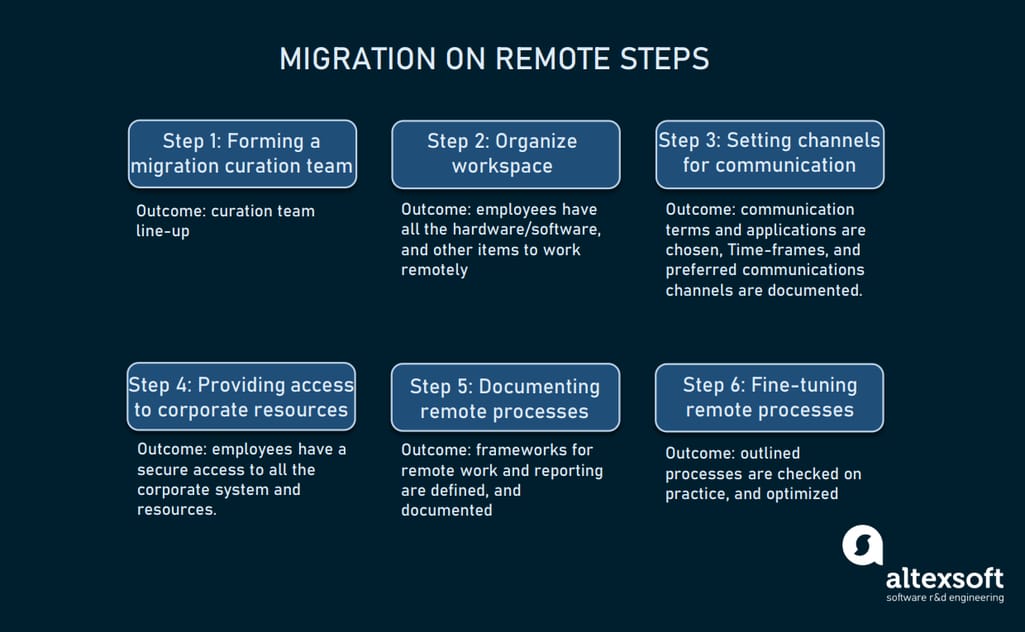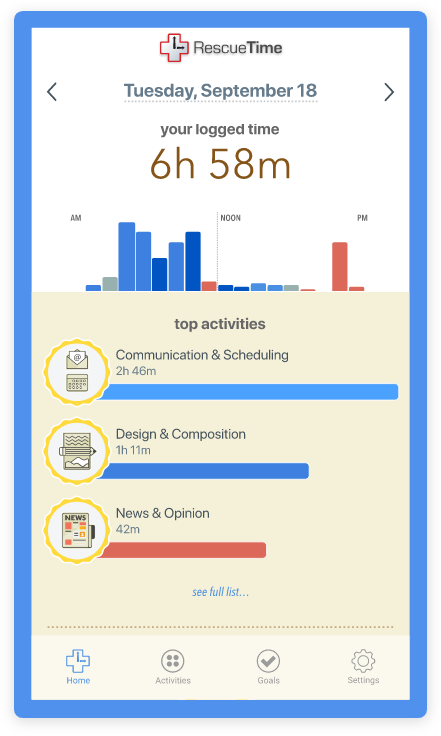Some say remote work is a dream: Your fridge is handy and you rule your time. But, some know that home isn’t the best place to get the job done. While the truth is somewhere in the middle, as of this writing, working remotely is a reality not a choice.
So, we'll be pragmatic: Running your business remotely is challenging. It requires modifying your communication, working processes, and infrastructure, which is mostly management’s pain. Regardless of why you decided to go remote, there are a bunch of things that need to be set up right, so your people can work seamlessly and bring value.
This article can serve as a guide for software businesses or any other companies working remotely. We’ll cover different aspects of work in a lockdown, giving you structured flows to prepare for remote, as well as some best practices on how to manage your workers from home.
How to migrate to the remote infrastructure
Since 2010 the number of remote workers has grown by 400 percent, and with the recent pandemic, industry minds rethink what remote can be in the future. That said, keep in mind that there are numerous companies across the globe that have always worked fully or partially remotely.
So, let’s begin with planning. Migration to remote is a multiple-step process that can take from a couple of days to infinity. But if you plan it right, you can cut expenses and transition quickly. The following recommendations are a compilation of practices of fully remote companies. These are based on GitLab’s Remote Playbook, Invision, Aha!, and morsels of our own experience.
Migration planning step-by-step, and the results you want to get on each step
Step 1: Form a migration team
Forming a migration team consisting of people who can lead the process of migration. These are the people in charge of planning, making decisions, finetuning, and actually executing the migration. The team should include people from various departments:
- Higher level management: C-level, department heads, who denote the general strategy of migration, set working hours, allocate budget, etc.
- Lower level management: Project managers, coordinators will be the closest people to communicate inside teams. They will basically collect the information on the desired format of work from their team members. They will also create reporting standards and communication channels to keep in touch with colleagues.
- Office administration: These people will be responsible for managing the inventory, helping workers transfer hardware, and answering the requests to buy/install something for the remote work.
- IT department: People from the IT department will carry software configuration for remote work. They will provide database/system access, take care of security, and so on.
- HR department: This group will partially help office administration with all migration needs. They will also inform people of the things that happen in the company, changes in the working process. HR will also create documents and references with organizational information.
All of these people are essential to ensure proper migration and support each employee with all the required information or infrastructure. The migration team should be functional and operative, so you should keep the roster of people as short as possible but keep all the required professionals in it.
The outcome: A documented set of people who will make decisions and curate the migration process for all of your employees. The list of people on the team with their responsibilities is shared across the organization so everyone has contact information of a responsible person.
Step 2: Workspace organization
Of course, any employee is in charge of drawing a virtual line between their bed and computer table. But here we can face lots of issues concerning hardware, software, internet connection, furniture, physical space, etc.
To organize the workspace properly, employees should have everything they need for work like they did in the office. So, it means we need to check if all the elements are present and serviceable. If they’re not, it’s an employee’s responsibility to cooperate with the remote team to resolve any issues.
We recommend you create a checklist to enable people to see that they have everything required for work. This can be a simple Google spreadsheet, or you can use your corporate tools to report such issues to the remote team.
The outcome: a list of required items every worker should have in their work space to accomplish their individual tasks. The list is checked with the employees and lower-level management. Required items are bought/moved to employees’ houses and software licenses are bought and provided to the users.
Step 3: Setting communication channels
Going remote means everything that can be discussed will be discussed online. To make it work, there has to be a set of communication channels where organizational, technical, and project details can be talked over.
Everyone knows how to use Skype and Zoom, so we won’t give you suggestions for dummies. Instead, we recommend you implement simple guidance for your employees to define:
- What apps will we use to communicate?
- Where do we discuss which things?
- How do we discuss them?
- What is the schedule of communication?
- Is there call-free time?
Such guidance is required to align everyone with understanding what, how, and when to communicate, setting clear processes for organizing calls and group meetings, discussing project-related and company-organization topics.
You also want to keep in mind that leisure communication between your development, testing, or designers be better kept in some workspace as well. This will help organize important information in one place, so that it can be hauled out later if needed.
The outcome: clearly documented communication formats between the team members, management, and stakeholders. The guidance should answer the questions of what apps to use, for which purposes, and if there is a schedule for some meetings.
Step 4: Providing access to corporate resources
Another important step is to open access to corporate resources like your internal website, reporting, time tracking, project management, repositories, ERP, etc. If any of these tools can be accessed only from your intranet, or by invite, you should think of it in advance. To avoid roadblocks here, some corporate tools can be deployed on a new server, as remote work may lead to higher loads and potential crashes.
The outcome: management members and employees can freely access all the required corporate systems and resources.
Step 5: Formulating processes for the remote work
Processes are better formulated during creation; we can’t handle them as effectively on the fly. So, it’s better to have a framework for everything related to remote work. The lack of self-organization, and different distracting factors will probably impact your employees, especially those who have had no freelance experience.
So, the rule of thumb is to create a framework for every process you can create one for.
- Define the flexible working hours for your employees.
- Set the remote culture across the working process, e.g. make it the custom to greet each other in the morning at the start of the workday or schedule calls for that purpose.
- Provide reporting standards for activities that are not logged to ensure you can keep track of KPIs.
- Set scheduled meetings to keep in touch with your people and discuss the way they work and what can be improved.
Unlike office work, short discussions can take too much time. So, it’s good to have a framework or a prompt document for everything. This will reduce the number of unwanted calls and discussions, as well as provide a clearer way for employees to handle their daily tasks.
An important note: this documentation doesn’t relate to software development/testing methodologies. So, try to keep it simple, it shouldn’t make the daily routine bulky and report-heavy.
The outcome: processual frameworks that can guide your remote workers through everyday activities.
Step 6: Finetune remote processes
Applied process frameworks won’t be perfect from the start, so we need to adjust them to the reality after some time has elapsed. For the sake of optimization, we can use what we’ve documented to understand what can be improved.
Another way to spot the performance bottlenecks in your daily operations is to conduct a 360-degree review. The 360-degree review concept is not new in the software development universe, and it’s basically a sort of group psychotherapy. Employees and managers of different levels are gathered to give feedback to each other, forming a 360-degree view of their working relations, communication, and interaction. These meetings are usually held with members of one team or people who closely interact with each other.
The outcome: Analyze your inner operations, spot the problematic points, and apply changes to optimize the remote processes.
Remote work tips and best practices
Modification of your remote organization will be a continuous process for sure. After you finish working on your internal processes, you can go back to change the lineup of the remote team or provide more reliable ways to communicate.
But, the described steps of planning are just a basic setup when the company goes remote. So, it makes sense to learn more about the established best practices on how to run the work remotely and manage distributed teams from home.
Take care of data security
Remote workers and companies in particular operate in a more vulnerable environment than the office. There are a couple of reasons why: workers may install unlicensed software, pass credentials through unprotected channels, ignore security system messages, or neglect antivirus software. Company-wise, access to corporate systems and resources shared via remote PCs becomes accessible to different types of fraud as well.
First of all, your system administration and IT department are in charge of providing secure access, setting VPN, and installing required software on the remote computers. Security issues deserve separate discussion, so you might read our article on how to choose fraud protection software.
Secondly, instruct your workers how to pass credentials and access sensitive information properly. Ask your HR department to compose a letter or create a guiding document where this information is available to employees. Include general information on security ethics, like tips for better passwords, SSL certification. Then be sure to provide information about popular fraud types, like phishing, or the man-in-the-middle attack.
Another tip is to use secure applications for your online communication. The recent buzz across Zoom security and privacy leaks shows that even messaging can be dangerous. So, it’s important to choose either more secure channels of communication, or always protect your calls with passwords.
Devote more time for planning meetings
Online conversations are a major part of working remotely, so different instruments for calls and messaging will become your second home. From that moment, it's important to plan meetings more precisely, as it may take most of the working day if planned incorrectly.
The second issue is a difference in time zones. If you have three people, one located in Phoenix, one in Brussels, and one in Tallinn, it will be challenging to actually set a convenient meeting time for everyone. So, here we can recommend you:
- Rely more on meeting planners and specific planners for different time zones, like WorldClock. There are numerous free alternatives on the web that instantly calculate time differences.
- Plan in advance – even some daily meetings – so that your attendees arrange their time if it’s early morning/late evening.
Consider communication format hierarchy
Different formats of online communication have different speeds of information exchange and set some limits on what type of information we can transmit. The hierarchy of these channels is a no-brainer.
- Video communication is the primary channel, as it allows us to transmit more types of data and makes it fast and convenient.
- Audio conversation is a traditional call – faster than text but limited compared to a video call.
- Instant messaging or any type of live chat is utilized the most to discuss something quickly.
- Emails are the slowest channel, used mostly to run the conversation in the background.
So, the tip is simple: The hierarchy applied to the choice of communication channel should take into account the priority of the discussion and type of information you want to discuss.
Allocate out-of-reach time
It’s a good practice to establish some time period when your employees can rest from endless conversations online and be out of reach. If you are dealing with remote teams in different time zones, try to arrange this time closer to the end of the working day.
The out-of-reach time should be used by employees to dedicate time for their tasks, so it's important you define this properly. The general advice here is to schedule all the necessary calls and conferences for the first half of the day. As remote involves lots of online conversation, employees are basically staying online until they go to sleep, which leads to emotional burnout and overwork.
Create a space for informal communication
Although this tip is valid for a pandemic lockdown, the practice of informal communication as a part of remote culture was established long before. Contrary to the idea of “spending less time online,” informal communication is an optional space where people can discuss anything they want.
A more exact definition of such space is a random chat. In a more organized form, these could be scheduled video conferences for coffee breaks. The main point here is to establish a space for employees to keep in touch with each other.
Use visualization tools
Besides the conversational tools, nearly all the instruments today are running in the cloud and have overtones of collaborative features. We use these tools to exchange information on a daily basis: Google Drive, Microsoft Office 365, iWork, and other office instruments. We also use screen sharing features in specific software or usual video conversation programs to show graphic information, code, mock-ups, and so on.
If you need to transmit graphic information on a regular basis, office suites don't fit such tasks. Instead use data visualization software that was built to create visuals out of raw text or numbers. You can share it with multiple people and automate the process of visualization. Here are some tools to try out:
These tools are free to use with some limitations of visualization and sharing features left for paid use. However, they still help with visualization of different analytics and sharing them across distributed teams or stakeholders.
Track as much as you can
People are different – some feel comfy working at home, while others experience distraction factors at home. Manager-wise it becomes fairly difficult to control how tasks are handled, and what the progress is if tasks are not tracked. You can observe how development branches are merged and modified by your team members, but it can’t really tell about the feature readiness.
Nobody wants to be a control freak, so the best solution is to provide a convenient way to track time, and actually track it for every task. Of course, productivity will fluctuate during the day, and work will break down to smaller time periods.
The interface of an automatic time tracker installed on a mobile device
Source: www.rescuetime.com
Automatic time-trackers like Rescue Time may track time spent on an app, website, or specific document without manual input. Coupled with short task descriptions can keep time-tracking a nice way to handle a job, rather than the time-sack itself.
Does working remotely always mean pain?
The short answer is probably not. There are thousands of companies running their business remotely. If we don’t take into account critical situations, there are a bunch of benefits companies can actually get shifting to remote.
Reduced rental costs. That logic there is everyone is working from home, so there is no need to rent an office, buy furniture, pay bills, and so on. What you can invest in instead is improving your employer’s qualification, keeping good salary rates, upgrading server-side hardware, and so on. A real case? In 2009 IBM got over 386,000 employees working remotely and saved $100 million for that year.
Wider talent pool. Ask your talent acquisition manager if it's difficult to find a required specialist in your location city. Hiring remote workers basically gives you an opportunity to hire a person from any corner of a globe.
Increased employee retention. That goes for small businesses struggling to retain specialists at their companies and unable to compete with larger corporations. Reducing costs for operations and rentals gives a business the wherewithal to compete on salary rate.

